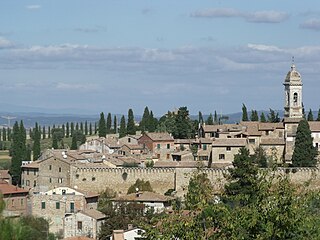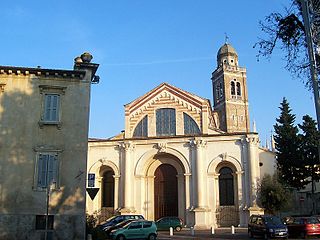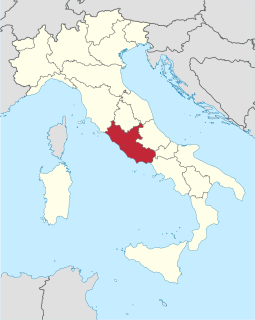
A chapter house or chapterhouse is a building or room that is part of a cathedral, monastery or collegiate church in which larger meetings are held. When attached to a cathedral, the cathedral chapter meets there. In monasteries, the whole community often met there daily for readings and to hear the abbot or senior monks talk. When attached to a collegiate church, the dean, prebendaries and canons of the college meet there. The rooms may also be used for other meetings of various sorts; in medieval times monarchs on tour in their territory would often take them over for their meetings and audiences. Synods, ecclesiastical courts and similar meetings often took place in chapter houses.

Cosmatesque, or Cosmati, is a style of geometric decorative inlay stonework typical of the architecture of Medieval Italy, and especially of Rome and its surroundings, and derived from that of the Byzantine Empire. It was used most extensively for the decoration of church floors, but was also used to decorate church walls, pulpits, and bishop's thrones. The name derives from the Cosmati, the leading family workshop of marble craftsmen in Rome who created such geometrical decorations. The style spread across Europe, where it was used in the most prestigious churches; the high altar of Westminster Abbey, for example, is decorated with a Cosmatesque marble floor.

The Visigoths entered Hispania in 415, and they rose to be the dominant people there until the Moorish invasion of 711 brought their kingdom to an end.

Pre-Romanesque architecture in Asturias is framed between the years 711 and 910, the period of the creation and expansion of the kingdom of Asturias.

The Vall de Boí is a narrow, steep-sided valley and a small municipality in the province of Lleida, in the autonomous community of Catalonia, northern Spain. It lies in the northeastern corner of the comarca of Alta Ribagorça, on the edges of the Pyrenees. It is the largest municipality of the region, with its main town being Barruera.

San Quirico d'Orcia is a comune (municipality) of about 2,500 inhabitants in the Province of Siena in the Italian region Tuscany, located about 80 kilometres (50 mi) southeast of Florence and about 35 kilometres (22 mi) southeast of Siena inside the Valdorcia landscape. It is named in honor of Saint Quiricus.

Fabrica di Roma is a comune (municipality) in the Province of Viterbo in the Italian region Latium, located about 80 kilometres (50 mi) northwest of Rome and about 25 kilometres (16 mi) west of Viterbo.

Santa Maria in Organo is a Roman Catholic church in Verona, Northern Italy.

Gothic architecture appeared in Italy in the 12th century. The bold architectural solutions and technical innovations of the French Gothic cathedrals never appeared: Italian architects preferred to keep the construction tradition established in the previous centuries. Aesthetically, in Italy the vertical development was rarely important.

The Monastery of Santa Maria de Ripoll is a Benedictine monastery, built in the Romanesque style, located in the town of Ripoll in Catalonia, Spain. Although much of the present church is 19th century rebuilding, the sculptured portico is a renowned work of Romanesque art.

The Collegiate Basilica of Santa Maria, also known as La Seu, is a Romanesque-Gothic church in Manresa, Catalonia, north of Spain.

Bellver de Cerdanya is a town in the comarca of Cerdanya, province of Lleida, Catalonia, Spain.

Civita Castellana Cathedral is a cathedral in Civita Castellana, central Italy. It is the episcopal seat of the Diocese of Civita Castellana.

The Churches of the Vall de Boí are a set of nine Early Romanesque churches declared World Heritage Site by UNESCO and located in the Vall de Boí, in the Catalan comarque of Alta Ribagorça.

Santa Maria d'Amer is a Benedictine monastery in Amer, Selva, Catalonia, Spain.

Nepi Cathedral is a Neoclassical Roman Catholic cathedral located in Nepi, region of Lazio, Italy. It is dedicated to the Assumption of the Virgin Mary and to Saint Anastasia. It was the episcopal seat of the Diocese of Nepi, later Nepi and Sutri, suppressed in 1986, and is now a co-cathedral in the Diocese of Civita Castellana.
Santa Maria in Pertica was a church once present in central Pavia, region of Lombardy, Italy.

Santa Maria Assunta is the main Roman Catholic church of Orte, located in front of the Piazza della Liberta of the town, in the province of Viterbo, region of Lazio, Italy. It is one of three co-cathedrals of the diocese of Civita Castellana, which since 1991 encompases the former territories of the dioceses of Orte, Gallese, Nepi, and Sutri, each of which has a co-cathedral church.
San Francesco, once known as San Pietro is a Roman Catholic located in the town of Civita Castellana, province of Viterbo, region of Lazio, Italy.




















